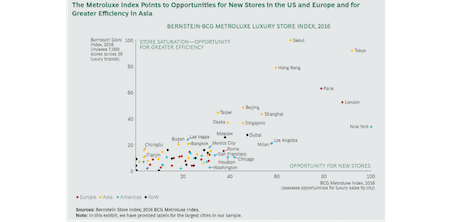Streamlining, optimizing to be retail buzzwords in 2017: BCG
After entering Asia at a high rate of speed, luxury brands quickly oversaturated the region which has caused a number of recent store closures and the need to rethink retail strategy, according to a recent report by Boston Consulting Group.
In its joint report with Bernstein, BCG found that market saturation paired with the prevalence of ecommerce has tested retail network efficiency. The research examines the current retail environment in top-tier Asian cities, why luxury brands shouldn’t forego store openings outside major cities in the United States and how ecommerce has impacted physical points of sale.
“There is still some potential for retail expansion in mature markets, especially in the U.S. and big luxury hubs around the globe in mature markets, contrary to what many think,” said Olivier Abtan, a Paris-based partner and global lead of BCG’s luxury topic.
“There is a need for store and square meter rationalization in Asia, and mainly in China: store closures, smaller stores, less presence in tier-2 or tier-3 cities,” he said.
The research was drawn from BCG’s Metroluxe Index that tracks luxury sales opportunities by city and the Bernstein Proprietary Luxury Store Database, an index of approximately 7,000 across 36 luxury brands used to map the current global luxury retail environment at the store level.
Retail today
Cities such as London, Paris and New York will always be a draw for tourism and luxury spend, but brands should fine tune their retail strategies outside of “leading fashion hubs.” This is especially true within the Asian market’s top-tier cities.
As the Asian market developed, luxury brands raced to open flagship in Hong Kong, Singapore and other top-tier cities to jockey for consumer awareness. The mass entrance resulted in an unsustainable presence for many brands because local consumer demand is unlikely to rise much higher than its current levels.
Although Tokyo, Seoul and Hong Kong are considered among the world’s six “luxury centers,” as are New York, London and Paris, the large populations and steady visits from tourists help to support the retail flagships found in these places.
In Asian cities, where luxury brands have created an unsustainably large retail footprint, store closures are expected to continue in select areas.
But, while shuttering a storefront is not necessarily seen as positive, a closure can bring forth opportunity for the brand in question. By reconfiguring its retail presence, a luxury brand can refocus on moving to a better, more suitable location, renegotiate rents and revise current store footprints to enhance selling capabilities.
While expansion into Asia’s major cities has stalled, BCG and Bernstein’s research suggests that the U.S. market still has room to develop.
Aside from its “well-served luxury hubs,” second-tier cities in the U.S. are under-penetrated by luxury brands despite wealth pockets in Boston, Washington, Dallas and elsewhere, for example.
Even though these second-tier cities do not have the same level of tourism when compared to Los Angeles or New York, their local populations are affluent enough to produce strong, steady sales for luxury brands.
For example, department store chain Saks Fifth Avenue is refining its contemporary offerings by opening the doors to its new speciality store concept, The Collective, in Greenwich, CT.
Although Saks’ flagship is in New York, the retailer has turned to nearby Greenwich, an affluent suburb not far from the city, as a testing ground for new in-store strategies. The wealth of Greenwich’s local community also ensures ROI (see story).
Ecommerce and the store
In September, BCG projected that online retail will represent 12 percent of the luxury market by 2020. Its report also found that about six out of every 10 luxury purchases are currently influenced by digital channels as social media, a brand’s Web site and mobile feed into buying decisions, whether the transaction is completed online or in-store (see story).
For many in the luxury space, this digital technology shift came much faster than expected and has proved disruptive for the industry as a whole. As a result of ecommece’s effectiveness, brands have been put on the “fast track” for omnichannel development.
According to BCG and Bernstein’s research, online sales growth has resulted in less need for physical storefronts. Going forward, this realization may result in less stores per city, on average in markets such as the U.S. when compared to other countries.
In Asia, the use of mobile devices and purchases made via ecommerce has rapidly advanced
“Independently from ecommerce development, retail development in Asia of luxury brands has been too fast and sometimes too deep,” Mr. Abtan said. “There have been too many stores/square meter including in cities where the luxury consumption is not there, and will not be in the near future.
“Ecommerce development has brought another layer of challenge to the physical retail footprint development, especially in China,” he said. “As luxury ecommerce develops further (growing at 30+ percent p.a), there will be more challenge on sales/square meter in physical stores in the future.
“Yet, we have seen recently (in the last 6 months) a trend towards more local consumption in China vs. in the past. Luxury stores have been enjoying nice sales growth in China but this can change with FX rate changes,” Mr. Abtan continued.
“The true challenge for the luxury brands in Asia, China or elsewhere in the world, is the implementation of a true omnichannel strategy. For example, leveraging the Web to bring more clients to the stores where they can fully enjoy the brand experience.”

